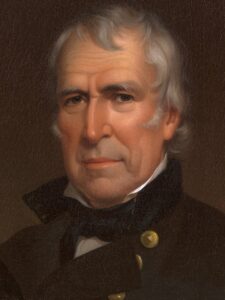Archive for October 1st, 2020
» posted on Thursday, October 1st, 2020 by Linda Lou Burton
#12. Taylor, Zachary
Linda Lou Burton posting from Little Rock, Arkansas –Zachary Taylor (November 24, 1784 – July 9, 1850) was the 12th president of the United States, serving from March 1849 until his death in July 1850. Yes, another president died in office. And under mysterious circumstances – there is still suspicion about the cause of his death. Strange that he died right after a picnic at the Washington Monument on a sunny day in July. And especially odd, since the man spent most of his 39-year military career fighting in battles that would have caused most folks to turn tail and run. But Zachary Taylor was a Clint Eastwood movie waiting to be made. A series of MAKE MY DAY events that, on paper, sound like tall tales. Surely it was fiction? No, it was not. Every one of his battle stories from the War of 1812, the Black Hawk War, the Second Seminole War, and the Mexican-American War would keep any fan of war movies so engrossed they’d forget to eat their popcorn. Pretty much all of them were “against the odds” encounters, but “Old Rough and Ready” Eastwood-Taylor always managed to beat those odds. Take the 1812 Siege of Fort Harrison, for example. Scene: Captain Taylor assigned to escort 80 men, women, and children from Fort Knox to Fort Harrison and take command there. The group was struck by malaria and many died along the way. Taylor was ill when he arrived, and learned that Indian forces planned to attack the Fort. Roll the reel.
 Only fifteen of the remaining men were soldiers; the rest were civilians or soldiers too ill to fight. Taylor recruited five civilians and gave the twenty men sixteen rounds of ammunition. Around midnight, they were awakened by fire. Taylor saw the flaming fort as an opportunity – the fire lit up the sky and revealed the attackers! Put out the fire, and shoot the attackers was Taylor’s plan and yes, the fire was put out and the 600 Miami, Potawatomi, Kickapoo, and Winnebago warriors retreated. Action scenes include civilian Julia Lambert lowering herself into the Fort’s well to fill buckets more quickly for the fire brigade, panicked shooting and shouting, and at the end, the daylight approach of Chief Namahtoha with a flag of truce.
Only fifteen of the remaining men were soldiers; the rest were civilians or soldiers too ill to fight. Taylor recruited five civilians and gave the twenty men sixteen rounds of ammunition. Around midnight, they were awakened by fire. Taylor saw the flaming fort as an opportunity – the fire lit up the sky and revealed the attackers! Put out the fire, and shoot the attackers was Taylor’s plan and yes, the fire was put out and the 600 Miami, Potawatomi, Kickapoo, and Winnebago warriors retreated. Action scenes include civilian Julia Lambert lowering herself into the Fort’s well to fill buckets more quickly for the fire brigade, panicked shooting and shouting, and at the end, the daylight approach of Chief Namahtoha with a flag of truce.
Would I invite this man to my party? Darn tootin’, especially if I had pesky neighbors that were always messing with my fort. Would you?
What Kind of Person
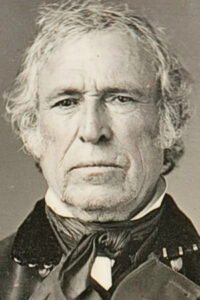 Zachary Taylor was a great soldier, and leader, if you asked his men. He marched through the woods or the swamps or the desert right alongside them. If you asked his superiors, you might get a different answer. Yes, he won battles, but he refused to dress up. He looked more like a farmer than a sharply dressed military man. He wore straw hats and dirty old boots and always had a grizzled rough and rowdy look. So how did he wind up as President of the United States?
Zachary Taylor was a great soldier, and leader, if you asked his men. He marched through the woods or the swamps or the desert right alongside them. If you asked his superiors, you might get a different answer. Yes, he won battles, but he refused to dress up. He looked more like a farmer than a sharply dressed military man. He wore straw hats and dirty old boots and always had a grizzled rough and rowdy look. So how did he wind up as President of the United States?
Zachary Taylor was born on a plantation in Orange County, Virginia, to a prominent family of planters. He was the third of five surviving sons in his family and had three younger sisters. His father Richard served as a lieutenant colonel in the American Revolution. A lot of name dropping with connections to the Mayflower; the family tree shows lines to James Madison and Robert E Lee. When that Virginia land became exhausted, Zachary’s family joined the westward migration and settled in Kentucky, on the Ohio River. Zachary was just a baby at the time, first they lived in a woodland cabin, then eventually as fortunes increased, a brick house. The town of Louisville grew rapidly and the family’s holdings increased to 10,000 acres and 26 slaves. Kentucky’s education system was just taking shape, so Zachary’s formal 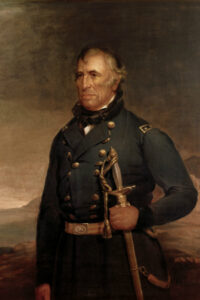 education was sporadic; his mother taught him to read and write and he received some training from classically trained scholars migrating west.
education was sporadic; his mother taught him to read and write and he received some training from classically trained scholars migrating west.
His Army career began in 1808 at the age of 23, one of the first new officers commissioned by Congress after an American frigate was boarded by the crew of a British warship. Wars and rumors of wars formed the direction of his life until he retired in 1848 after receiving three Congressional Gold Medals for his service in the Mexican-American War; the stage was set for a presidential election.
In between battles and wars he purchased a good deal of bank stock in Louisville, bought a plantation there and another in Mississippi Territory, and acquired more than 200 slaves. He also got married and fathered six children with Margaret Mackall Smith (1788-1852). Peggy came from a prominent family of Maryland planters; she and Zachary met in Louisville and married in June 1810. Three of their daughters lived to adulthood; son Richard became a Confederate Army general.
In all those years as a career officer, Zachary never publicly revealed his political beliefs, and he never voted. He thought of himself as an independent and believed it was impractical to expand slavery into the western areas of the country, as neither cotton nor sugar could easily be grown there through a plantation economy. He was a firm nationalist; due to his experience of seeing so many die as a result of warfare, he believed secession was not a good way to resolve national problems.
Presidential Days
 The Whig Party convinced him to lead their ticket in 1848 despite his unclear political tenets and lack of interest in politics. And Zachary Taylor became the first president to be elected without having served in a prior political office, winning with 163 electoral votes to Lewis Cass’ 127.
The Whig Party convinced him to lead their ticket in 1848 despite his unclear political tenets and lack of interest in politics. And Zachary Taylor became the first president to be elected without having served in a prior political office, winning with 163 electoral votes to Lewis Cass’ 127.
Zachary headed for Washington in late January – due to bad weather, illness, delays, and even a kidnapping by a friend as a joke it took a month to get there; though he officially became president Sunday, March 4, his inauguration took place the next day due to religious considerations. His inauguration speech discussed the many tasks facing the nation; after his inauguration, he made time to meet with numerous office-seekers and ordinary citizens who desired his attention. He also attended a number of funerals, including services for former president Polk and for Dolley Madison. Throughout the summer of 1849, he toured the northeastern states to familiarize himself with the region.
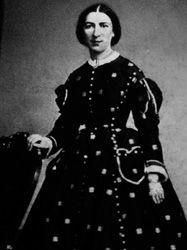 Margaret Taylor had literally prayed for her husband’s defeat, dreading the personal consequences of his presidency. The hardships of following him from fort to fort and caring for their children had taken their toll; she was a semi-invalid by the time she arrived at the White House, and remained on the second floor, leaving the duties of official hostess to their daughter Mary Elizabeth Bliss.
Margaret Taylor had literally prayed for her husband’s defeat, dreading the personal consequences of his presidency. The hardships of following him from fort to fort and caring for their children had taken their toll; she was a semi-invalid by the time she arrived at the White House, and remained on the second floor, leaving the duties of official hostess to their daughter Mary Elizabeth Bliss.
Zachary Taylor didn’t die on July 4, as three of his predecessors did, but he did get sick. That afternoon at the holiday event taking place across the street from the White House, where the Washington Monument was under construction, he overdid it. Some stories say it was cherries he ate. Way too many cherries for a man who’d always suffered from gastrointestinal problems. And since it was hot that day, he then consumed iced milk. It was several days before he became seriously ill and developed a fever. The doctors tried everything they knew, but on July 8 he remarked to an attendant:
“I should not be surprised if this were to terminate in my death. I did not expect to encounter what has beset me since my elevation to the Presidency. God knows I have endeavored to fulfill what I conceived to be an honest duty. But I have been mistaken. My motives have been misconstrued, and my feelings most grossly outraged.”
This is one battle “Old Rough and Ready” didn’t win. He died the next day, July 9, 1850, at the age of 65, and was interred in the Public Vault of the Congressional Cemetery in Washington until October, when his body was transported to the Taylor family plot in Kentucky. Almost immediately after his death, rumors began to circulate that he was poisoned by pro-slavery Southerners; his body was exhumed in 1991 and radiological studies were conducted of samples of hair, fingernail, and other tissues. Neutron activation analysis conducted at Oak Ridge National Laboratory revealed no evidence of poisoning, as arsenic levels were too low and concluded he contracted “cholera morbus, or acute gastroenteritis.” Speculation continues; a 2010 review states “there is no definitive proof that Taylor was assassinated, nor would it appear that there is definitive proof that he was not.”
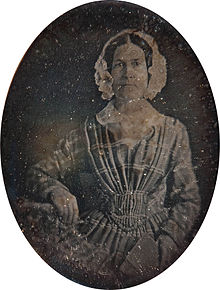 Margaret Taylor’s health deteriorated rapidly after Zachary’s death; she died two years later in Mississippi and is buried in Kentucky next to her husband. Few pictures are available of her, some have surfaced on the collector’s market but not been authenticated. Little has been written about her; here is an article from a newspaper social column when Zachary was being considered for the presidency:
Margaret Taylor’s health deteriorated rapidly after Zachary’s death; she died two years later in Mississippi and is buried in Kentucky next to her husband. Few pictures are available of her, some have surfaced on the collector’s market but not been authenticated. Little has been written about her; here is an article from a newspaper social column when Zachary was being considered for the presidency:
MRS. GENERAL TAYLOR AND DAUGHTER.-—At a late ball, at East Pascagoula [Mississippi], General Taylor, his lady and daughter and Major Bliss, were present. Of them a correspondent of the Mobile Herald writes as follows:— Mrs. Gen. T.—Dress plain, and in good taste; manners dignified and easy, countenance rather stern but it may be the consequence of military association. Person tall and commanding, demeanor retiring, with no palpable predilection for high station; and, judging from appearance, one would suppose the White House offers no peculiar attractions to Mrs. Gen. T., and if her ‘liege lord’ would listen to her sage and wel[l]-considered counsel, it is not unlikely he wou[l]d be content to remain as Gen. T.
No doubt true. And he would have made a great movie star.

